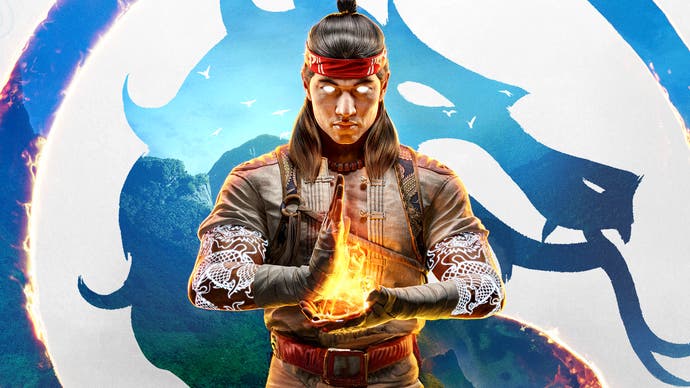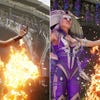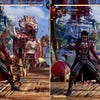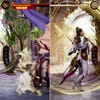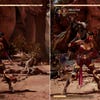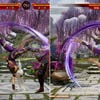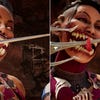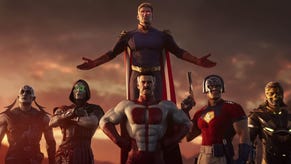It's true: Mortal Kombat 1 on Switch is just too big an ask for the hardware
But the game truly shines on PS5 and Xbox Series hardware.
Mortal Kombat goes back to its roots with Mortal Kombat 1, a fresh reboot that delivers some of the most striking visuals seen from a fighting game to date. Lighting quality, materials across its detail-rich stages and motion capture are all brilliantly realised on Unreal Engine 4 here. It's a big revamp over Mortal Kombat 11, with developer Netherrealm Studios focusing its efforts on current-gen consoles, but in a surprise turn, a Nintendo Switch version is available, handled by Shiver Entertainment and Saber Interactive and as the social media memes have revealed, it's not particularly impressive. In fact, Netherrealm's Ed Boon has pledged to fix it. Based on what we've seen, this would be an remarkable feat.
Part of the controversy is that the Switch version costs £60 or $70 on the Nintendo eShop- just shy of the PS5 and Xbox Series X price at launch. Given the frankly huge compromises to its visuals and highly inconsistent frame-rate, it's not an equivalent experience for the cost. In terms of install size, MK1 on Switch takes up 35.3GB, up against 114GB on PS5. This is achieved, in large part, by dropping the bitrate and resolution of its story mode's pre-rendered cut-scenes. And therein lies at least one bit of good news for Switch: as pruned-back in quality as it is, this version is at least feature complete. In terms of modes it has parity with PS5 and Series X in bringing the entire story mode - with cutscenes intact. We get online play, we get the full roster of characters, and its gameplay is identical in its mechanics, right down to the new Kameo moves.
However, the problems are legion. To start, the Switch release has issues in lengthy load times and unresponsive menus. Kicking off at the title screen, selecting the local versus mode takes Switch 15 seconds to simply get to character selection. On PS5 or Series X we'd usually get a seamless transition here, with two combatants walking in from the screen's edges. It's a stylish idea that takes us right through to the battle itself. On Switch though, every character takes time to load after selection. And as Switch attempts to load your character, the menu itself becomes sluggish. The cursor hitches - making it hard for player two to also make their choice. It only gets worse from here: after you've finally picked your two characters and stage, the real wait begins with a circa 40 second wait until the Kombat begins. To a large extent this is expected, and it's realistcially never going to be a match for the SSD-equipped Series X, which come in at six seconds in the same test, but it remains frustrating.
Then there are the visual downgrades to consider. Pitting Switch against PS5 for example, the first point is the drop in native resolution. Docked play on Switch runs at a dynamic 756p - that's 1344x756 max, while the lower bounds come in at 576p during more GPU-intensive stages. Honestly, this is par for course on Switch, and there's obviously no competing with PS5's many-times more powerful GPU, which affords it a dynamic 4K setup, scaling down to around 1800p. Interestingly, Switch runs at its peak 756p in intros and fatalities, where the frame-rate caps at 30fps. And in fairness this is also a higher resolution range than the 540p to 720p we had in Mortal Kombat 11 on Switch. Compared to PS5, the downgrade is obvious but relative to most Switch games, this what we'd expect for it to stand even a remote chance of targeting 60fps gameplay. And of course, portable play drops that resolution range even more so, down to a dynamic 720p, while its lower bounds come in at 704x396. The good news there, at least, is that Switch's smaller screen helps disguise the lower pixel count.
Resolutions aside then, the drop in visual settings across the board are impossible to ignore. In fact, it's easier to describe what hasn't been pruned back from the PS5 version. Every facet of Switch's visual make-up is touched upon: there are lower grade textures, while texture filtering takes a hit. The polygon count on models, plus the geometry in the background, are visibly dropped in complexity. Foliage is stripped out, or otherwise lowered to a simplified plant or tree model. Effects are removed, or culled in resolution - often dulling the impact of special moves. Screen-space reflections are axed from the Switch release across the floors. All round the result is still recognisable. In still shots it's essentially a mobile version of the game, and it's impressive how deep visual trade-offs go. You'll notice the lighting model is altered too, and so, shadows are stripped out from the background, while character shadows appear at a different angle on Switch. But then, on specific stages like the Hanging Gardens, shadows are even entirely removed from characters during fights.
There's a lot to take in then. The question is, to what extent are these visual cutbacks are acceptable? And does it truly affect the Mortal Kombat experience? No doubt, the texture quality in certain stages - like the Hourglass - is glaringly low even for a Switch port. It's a distraction to see entire surfaces - rock formations, mosaic floors - appear as a blur, behind much more sharply defined characters. Also it's a shame to see background characters no longer animate at all on Switch. Expect a lot of static elements like this in the background: NPCs frozen in place. Interestingly though, cloth and even water physics are kept enabled, while select foliage also sways to the wind. Physics are less extensively applied, certainly. At times they're simplified. But still, it's a surprise to see at least some physics-based details making the cut even on Nintendo's handheld.
Cutscenes are also problematic on Switch. Motion capture on PS5, Series X, S and PC is expertly delivered by Netherrealm Studios as always. Sadly though, facial capture details do not translate well to Nintendo's handheld -and has been the source of many memes since its release. Full body motion capture is intact, but the most glaring issues relate to missing character mouth and eye animations. They're static at points, creating uncanny moments during in-engine intros. Worse still, there are numerous visual bugs during intros, an fatalities, that spoil the experience too - including collision issues on characters as their teeth don't sync with the movement of their mouths. Likewise, even the story mode has clear issues, with flickering shadows across characters, right from the first bout of fights. Plus, there are stretches of tearing and hitching during the pre-rendered scenes on Switch, which is likely a CPU contention issue as Switch loads the next stage behind the scenes.
All round it simply lacks the level of polish to justify its price tag. And given Mortal Kombat's core appeal is so tied into its presentation, it's clear that Switch misses out. For the full package on console then, PS5, Xbox Series X or S are the ones to go for. We already know where PS5 stands and on Series X we get the exact same setup: a dynamic 4K with drops to an 1800p lower bounds. And to be clear, every visual setting is precisely the same between the two premium consoles. It's only on Series S that we see any real visual difference. In comparison, image quality is dropped on Series S, with it resorting to a dynamic 1440p - lowering to 1080p during GPU-heavy moments. But it goes further as textures can lower in resolution while shadow quality takes a hit. It's still absolutely a great experience on Series S and most of the compromises are hardly noticeable: it's only minor points that take a hit, like dropped foliage quality, geometry, or reduced decorative elements. Otherwise, you're getting much the same experience across all three.
Moving on to performance, the state of PS5, Series X and S is best summarised as a solid 60fps in gameplay. Even with four characters on-screen - two combatants, and two Kameo fighters - it barely drops a frame from 60fps on any machine. Great news then, and the fact is even Series S' cut to 1440p, with a drop in select visual settings, gives us a watertight 60fps too. It's exactly what we'd expect. The only downside, as is the trend with 3D Mortal Kombat games, is each console caps to 30fps during intros, fatalities and outros. This transition from 60fps gameplay to 30fps scripted moments is still jarring to see.
Worse still, these 30fps scenes at times suffer from bouts of hitching as the level first loads. Again this applies to all three consoles, and interestingly, this half refresh allows each to push higher settings. All run at their maximum res targets during intro scenes for example: so 4K on PS5 and Series X, or 1440p on Series S. Also, depth of field, and camera-based motion blur engage in these moments. Plus, shadow maps are added in cutscenes for extra background detail. The frame-rate switch does ultimately have a purpose in pushing better, crisper visuals where the game needs it, then. The setup might not be to everyone's tastes, but the upside is we do get 60fps where it counts in gameplay.
Jumping over to Nintendo Switch next, this is the make or break moment. For all its visual cutbacks, the lower resolution, the pay-off must be in getting that 60fps reading locked down. But alas, Switch really doesn't deliver. First impressions are sobering. The intro cutscenes jump between 10fps and 30fps, complete with big frame-time spikes down to below 200ms. It's a juddery, uneven experience from the word go. And most glaring of all is that Switch actually freezes on a character after their one-liner for several seconds, until the next fighter loads up their reply.
And then the combat itself kicks in. The frame-rate unlocks to 60 frames per second but the fact is Switch has huge issues keeping this locked down - with bouts of play often plunging down to 30fps and even lower. The typical baseline performance is at 55-60fps. For long exhanges it will run this region at least. It's just that huge lurches to 30fps still trigger often enough, usually coinciding with Kameo assists. In other words, all it takes is one or two Kameo characters to be summoned on-screen and the frame-rate immediately takes a nose-dive.

In the end, the new mechanic of Mortal Kombat 1 is the element that tanks Switch's performance. Unlike PS5 or Series X, actual gameplay is prone to suddenly running at 30fps as a result, midway through a combo - not just cutscenes. It seriously affects playability in any real competitive sense. For Switch, it's also unfortunate that these drops drag the rate of animation down a touch too, meaning character movement slows in cut-scenes especially. All of this applies directly to Switch played in portable mode as well, it's worth stressing. Visual settings are broadly the same as docked besides of the resolution drop, but clearly, performance struggles with a wavering 30-60fps readout - and even under. There's no skirting the reality that, played docked under a TV, or portable, Switch is in great need of attention to get it into a more playable state. And yes, right now it's again hard to justify its high price tag.
One last point on performance - and input latency in particular. As with Street Fighter 6, I had help from latency testing expert Nigel Woodall - whose socials are well worth checking out. Nigel flagged some interesting results after many hours of testing using his unique camera-based method. Using the down button as the testing regimen, PS5 for example has input latency at around 58ms - which is very reasonable. That is using a 60Hz output, where 120Hz appears to push the reading slightly higher.
By comparison Switch runs at 65.5ms on average meanwhile, which on paper is respectably close. it's only seven milliseconds off the pace, as an average. However, he notes that there is a much wider distribution of readings on Switch, a range of around 40ms not seen on PS5. All of which means, from input to input, there's a more variable response level on the Nintendo release. And this disregards the extra latency incurred by drops under 60fps, which will also affect the on-screen response. At least for PS5 then, as a ballpark sample of where the premium consoles stand, it's a good turnout. And in fact it's a marginal lead over Mortal Kombat 11 on PS5, which ran with a slightly higher 62ms result.
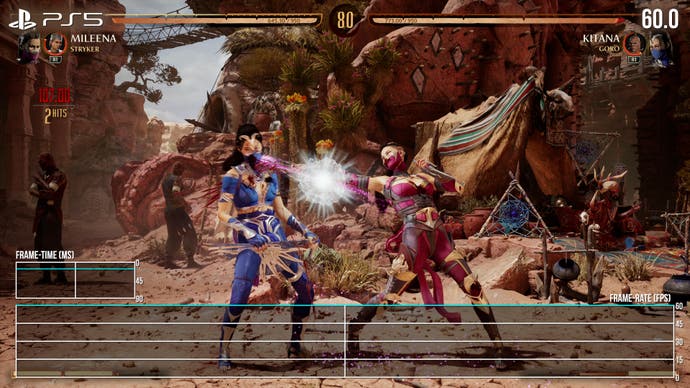
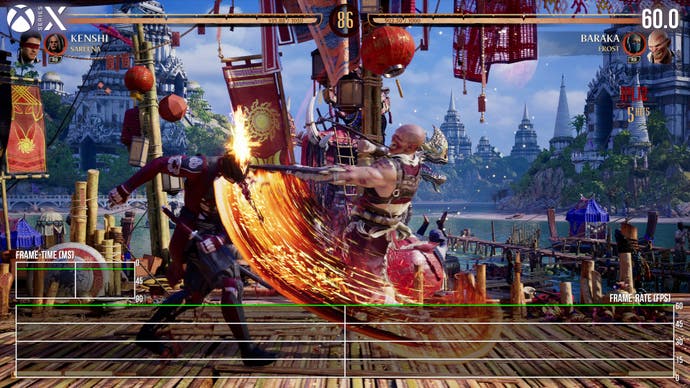
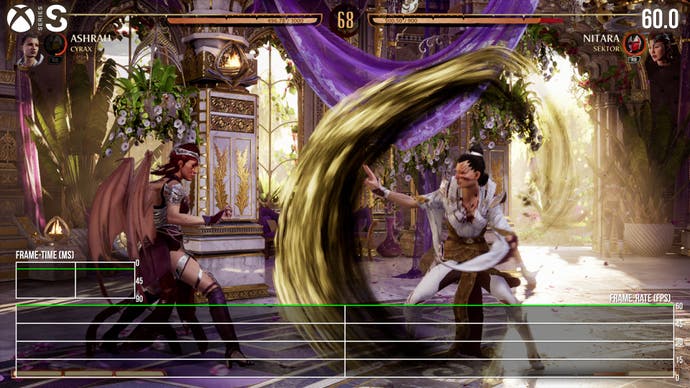
Overall then, despite all the visual cutbacks, the real sting in the tail for the Switch release is that there's no pay-off for playability. The performance as it stands at release is very poor. Oddly enough, it stands in contrast with the Switch version of Mortal Kombat 11 back in 2019. MK11's visuals were stripped back in many respects, but it still ran closer to 60fps than this year's entry. It wasn 't perfect, but at least there were no sudden lurches to 30fps mid-combo. And even loading times were quicker, at around 26 seconds to get into a fight.
As for Mortal Kombat 1 today, the level of optimisation - the balance between visuals and performance - is not on the same level. Fortunately, series creator Ed Boon has at least mentioned in a BBC interview that he's looking to address the Switch issues in a future patch. But right now, given its price and its sluggish menus, long loading times, bugs and poor frame-rates - it is one to avoid.
None of this should discredit the excellent work that's gone into the PS5, Series X and S release of course. Honestly, the game's a blast to play on any of those consoles. Take your pick. Gameplay itself is rock solid at 60fps, and each avoids the visual bugs of the Switch release. To enjoy the story mode as it's intended, to see the fatalities in all their bloody glory, there's truly no wrong version to go for there. And as a fighting game, Mortal Kombat 1 yet again sets a high bar of quality in its cinematic presentation that, for newcomers or long-time fans, is well worth checking out.
